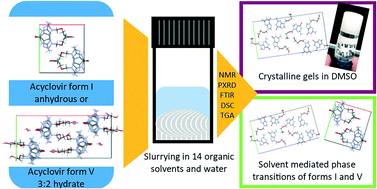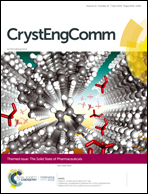Solvent driven phase transitions of acyclovir – the role of water and solvent polarity†
Abstract
Acyclovir, an antiviral purine derivative listed on the WHO's Model List of Essential Medicines, is commonly used in several different dosage forms from tablets to gels, oleogels and suspensions. Although temperature driven phase transitions of its commercially available 3 : 2 hydrate have been known since 2011, information on the solvent driven phase transitions of this drug has been limited. This study identifies the pathways of transformations of acyclovir forms I and V induced by organic solvents and water using the method of solution mediated phase transformation. The 3 : 2 hydrate, form V, undergoes dehydration to anhydrous form I in methanol, ethanol and N,N-dimethylformamide. Form I converts to anhydrous form II in dry methanol and N,N-dimethylformamide, while increased water content in the solvent prevents the transformation of form I to form II. Both forms I and V yield a gel-like material in dimethyl sulfoxide, composed of highly crystalline form II and reported here for the first time. Furthermore, significant differences in the thermal dehydration process of forms V and VI were observed using VT FTIR, including the first time report on a novel metastable ACV form VII formed upon dehydration of ACV dihydrate (form VI). High resolution solid-state NMR spectra of two anhydrous polymorphs (forms I and II) and two hydrates (forms V and VI) supported by DFT calculations using the CASTEP code are also presented.

- This article is part of the themed collection: The Solid State of Pharmaceuticals


 Please wait while we load your content...
Please wait while we load your content...